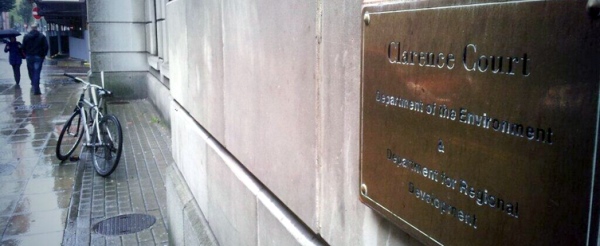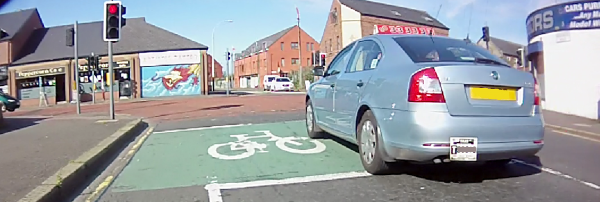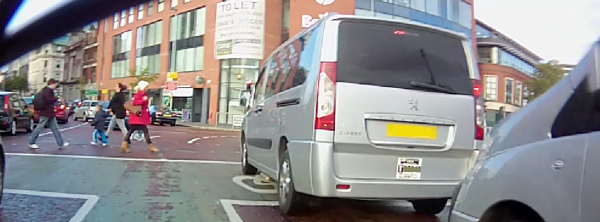
An announcement is due soon from Regional Development Minister Danny Kennedy on allowing taxis full access to bus lanes in Northern Ireland. With Department for Regional Development (DRD) officials recommending go ahead over clear, vocal and overwhelming objections, it’s time to take quick a step back and ask how we got to this point, and why DRD’s priorities are so muddled? Here are five key issues:

.
Apologies to the rest of NI for another Belfast-centric post, but the vast majority of bus lanes are situated in the greater Belfast area, and one fifth of taxis currently operate here, which could rise under the new licensing regime.
How much will this damage cycling uptake?
Belfast has an ‘aspiration’ to raise the level of cycling in the city to 10% modal share by 2020. Not an official target mind you, which might bind a government department to actually delivering it. This why we fail – we still have one of the lowest modal shares in the whole of Europe.
In the decade to 2011 there has been 60% rise in the number of Belfast commuter cyclists – that’s a 2.1% modal share and almost 2,300 regular cycling commuters. Some areas of south Belfast are already upwards of 5% modal share. We need to add over 8,000 more cyclists to Belfast rush hour to get to 10% share.
This kind of massive surge hasn’t happened to date, so why would busier, more intimidating bus lanes make it more likely to happen?
And what do we lose by denying taxis the use of bus lanes? 24% less people travel to work by taxi than in 2001, down to just over 3,000 people, or a 2.9% share. If these two trends continue, cycle commuters will reach parity with taxi commuters by 2015, and by the next census, the current levels will be reversed in cycling’s favour. That would be just 3,000 cyclists by the way – if we want a total of 10,000 cyclists on our rush hour bus lanes by 2020, why threaten that aspiration for the sake of dwindling numbers of taxi users? Madness.
Why are people in Belfast dissuaded from road cycling? In a recent survey of Belfast residents, 60% of people felt roads were too dangerous for cycling. So why is DRD salting the earth for the sake of a declining taxi commuting sector?

.
Why has DRD not listened to objections?
86% of the rubber stamp exercise consultation responses were negative, yet how did DRD choose to handle this? With a real slap in the face to those who responded with the ‘wrong’ view – lumping everyone together with one phrase, “mostly from cyclists“, and dismissing all fears as unfounded.
I’m guessing there’s a warped logic at work – if you can distill 60 objections in to one incorrect opinion, and weigh that against fully 7 (seven) responses welcoming the proposed changes, then we have a majority in favour! That’s how government works! The logic doesn’t work both ways though – just ignore the fact that the 7 (seven) positive responses were mainly from private taxi hire firms. Shhh!
Given the overwhelming negative view on the issue, how will DRD address cyclists’ safety concerns? See if you can hear it..
[soundcloud url=”http://api.soundcloud.com/tracks/78152979″ params=”” width=” 100%” height=”166″ iframe=”true” /]
Audio sourced from the Northern Ireland Assembly – subject to Parliamentary copyright.
If you sent an objection in to DRD, why not follow it up with a complaint that your objection has been effectively disregarded?
Northern Ireland taxis are now…sustainable? Really?!
The whole world will shortly be coming to Northern Ireland to learn how we’ve solved that pesky problem of motor vehicles wrecking the environment. A saloon car taxi (typical of the roughly 1,500 Belfast private hire vehicles) might carry an average of 1-2 passengers per fare, and yet DRD are claiming sustainability is no longer an issue! Listen to this:
[soundcloud url=”http://api.soundcloud.com/tracks/78148272″ params=”” width=” 100%” height=”166″ iframe=”true” /]
Audio sourced from the Northern Ireland Assembly – subject to Parliamentary copyright.
In a public policy exercise as intellectually bankrupt and dishonest as taxis in bus lanes, this marks a new low.
All those saloon cars driving around with 1-2 passengers are perfectly sustainable, as long as they are designated so by government.
DRD should pass this trick on to the Department for Finance and Personnel. Northern Ireland can dump Air Passenger Duty for short haul flights too by simply designating all aircraft as ‘sustainable’. I think Sammy Wilson might actually be game enough to try it..

.
Why damage journey times for 13.5% of commuters, for the sake of 2.9% of commuters?
There are no government targets to increase taxi usage – why would there be? Yet this entire policy seems entirely designed for that one purpose. Meanwhile, by the hard numbers from Census 2011 again, 13.5% of people use buses to get to work. In terms of sustainable objectives, reducing rush hour traffic and increasing revenue take for Translink, more bus passengers is a big goal for Belfast.
Just 2.9% of people used a taxi as their main form of transport to work in 2011, down from 4% in 2001.
Metro and Bus Rapid Transit efficiency of service will be one of the big factors which determine success of public transport in Belfast. The consultation itself recognised that taxis in bus lanes would have a negative impact on buses. A report from Amey in 2008 stated “bus lanes are currently underperforming against targets…additional vehicles in the bus lane … would probably contribute to further reduced bus journey speeds”.
How destructive can one little policy be?!
[youtube http://www.youtube.com/watch?v=HOK6mE7sdvs]
.
What is really driving this policy?
Taxi firms must have some truly amazing lobbying powers. Northern Ireland’s wonderfully transparent political system doesn’t allow us the luxury of seeing donations to political parties. So we’re left to wonder why such a poorly designed policy is being railroaded through a hostile consultation exercise, and if the policy wonks have given any weight to the potential damage it could cause?
Is Minister Kennedy running the risk of fatally undermining both Belfast Rapid Transit and the city’s blossoming cycling potential? Two birds, one stone – well it’s more efficient than a Belfast bus lane.
[youtube http://www.youtube.com/watch?v=i3StCJI-tnY]
.
What the people say about taxis in bus lanes
I have rarely seen a decision with so little merit and such obvious vested interests than taxis in bus lanes. A low point for the DRD. #sad
I have rarely seen a decision with so little merit and such obvious vested interests than taxis in bus lanes. A low point for the DRD. #sad
— Wesley Johnston (@niroads) February 7, 2013
@nigreenways @edsimpsonni If taxis are allowed into bus lanes by DRD I will have to retreat to the pavement. Too many run-ins.
— Borghert Borghmans (@StripyMoggie) September 5, 2012@nigreenways @stripymoggie Agree entirely that DRD screwing this up.
— Ed Simpson (@EdSimpsonNI) September 5, 2012@nileyb666 Shocking plan from DRD to slow bus journeys, increase road danger for cyclists -time to act ow.ly/duDyz via @nigreenways
— QUB_FoE (@QUB_FoE) September 5, 2012@nigreenways great article! it’s really shocking. I think a ‘boilerplate’ email template here would help more people get their responses in.
— Belfast Bike Lanes (@belfastbikelane) September 6, 2012@nigreenways I’m still scared on the road at anytime! Wld prefer separate bike lanes!
— callie persic(@calliepersic) September 7, 2012@nigreenways Logic in the consultation doc, para 7.6 is “60% taxis already use bus lanes illegally on Lisburn Rd” drdni.gov.uk/index/freedom_…
— Bob Harper (@GenesisPOrridge) September 14, 2012@nigreenways Confession time… I have a taxi licence, which shows they’ll give one to anybody. Self employed taxi men in bus lanes is mad!
— Paul (@Bedhead1157) September 19, 2012@nigreenways just filed my complaint about buslane consultation – I’ll bet they have all responses filed to ‘Delete’ :-/
— Steven (@Steven9740) September 20, 2012@petersomersett @steven9740 agreed, I’ll be ‘taking the lane’ – just wonder how someone who’s never cycled feels about that
— NI Greenways (@nigreenways) February 7, 2013@nigreenways @petersomersett this is an absolute disgrace. I pity any new cyclists in this city
— Steven (@Steven9740) February 7, 2013@nigreenways sadly, I concur.
— Chapeau76 (@Chapeau76) September 21, 2012@nigreenways Curiously they have the strap-line “Improving quality of life…for everyone”, but evidently not those who use active travel
— EdinburghCycleChic (@EdinCycleChic) September 4, 2012Letting taxis into bus-lanes will so obviously kill cyclists it is verging on premeditated murder.
— Newton Emerson (@NewtonEmerson) September 19, 2012@stephennolan definitely not. Absolutely no good reason to allow it. Will only slow up sustainable transport
— mcstick (@mcstick) September 21, 2012I think if taxis are allowed in the bus lanes, every time you have a run in with one, you should report it to the PSNI and DOE.
— Paul (@Bedhead1157) February 7, 2013
@nigreenways absolutely disgusted by this decision… Thanks for highlighting. Great article, I will write to complain.
— Rachel Overton (@Rachel_Overton) February 7, 2013
If DRD allow taxis in bus lanes it will be a ludicrous decision, making a mockery of consultation and clearly satisfying a vested interest.
— Wesley Johnston (@niroads) February 7, 2013
@stevenagnew So bus lanes are now just speedways for the McCausland’s? Do they have more votes than me at the ballot box? Or are we USA’d?
— Aráto_of_Ulster (@AratoOTeach) February 8, 2013
